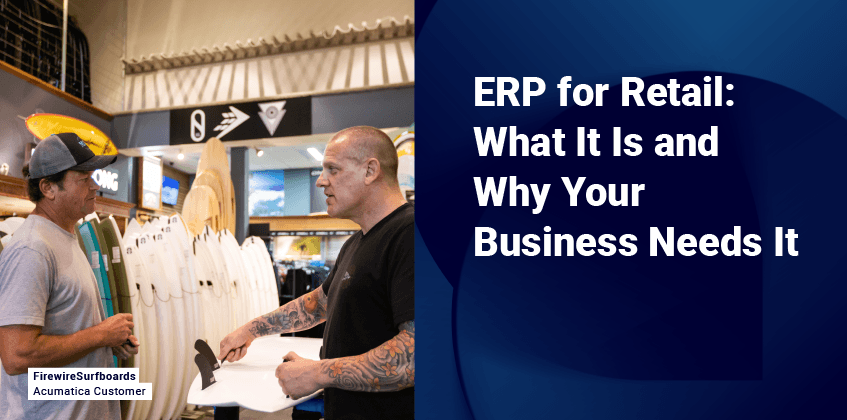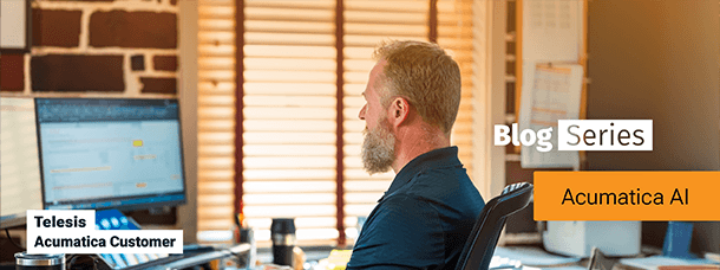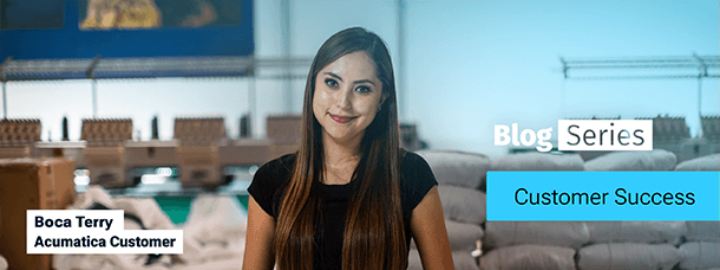
Why Your Retail Business Needs ERP Strategies
Every industry focuses on meeting and exceeding customer expectations. This is especially true in retail where companies are always on the front-line of customer engagement. For retailers to successfully sell their merchandise—in physical stores, on websites, through mobile applications, or all three (a.k.a. omnichannel commerce)—they must first understand who their customers are, what their customers want, and how they can ensure their customers’ needs are met quickly and efficiently. And they need to do it all better than their competitors.
It’s a tall order, and, to fill it, increasingly more progressive retailers are turning to comprehensive, cloud-based retail ERP solutions to understand their customers. Put simply, a cloud ERP solution is an end-to-end business management system that acts as the centralized storehouse for the reams of data a company and its third-party applications produce every day. With built-in business intelligence and analytical tools, such ERP software gives the company what it needs for strategic, growth-focused decision-making.
Retail-specific ERP systems should also seamlessly integrate with eCommerce solutions or digital commerce platforms, connecting a business’s finance, purchasing, and inventory data with its revenue system and customer-facing website. This helps retailers consolidate orders, automate fulfillment processes, streamline workflows, and so much more.
The exact features and benefits retailers receive from an ERP solution depend on the solution they choose. At base, the best ERP system for retailers should have the following features.
- Customer relationship management functionalities that gather, store, and help companies analyze and responsively serve their clients, which fosters customer loyalty
- Smooth connectivity between the customer-facing and back-office segments of the business, which aids collaboration, helps employees execute coordinated branding and marketing strategies, allows retailers to reach wider audiences, and helps companies build trust with current and future customers
- Enhanced reporting capabilities for deeper, data-driven insights into the health of the entire business, which leads to more accurate, strategic decision-making
Let’s look at each of these benefits more closely.
Using an ERP Solution to Improve the Customer Experience
Customer experience (or CX) is the single most important factor that determines whether a retail business succeeds or fails. According to PwC, after several bad experiences, 59% of US customers will walk away from a company to which they were once loyal. And, for 17%, one bad experience is enough to have them walking out the door for good.
Of course, what makes an excellent CX can vary from person to person, but PwC reports that “nearly 80% of American consumers say that speed, convenience, knowledgeable help and friendly service are the most important elements of a positive customer experience.” Customers expect the technology a business employs to be “elegant and user-friendly” while also unobtrusive, and that technology must provide automation capabilities that make their experience personal and seamless.
An ERP system for retail enables you to provide the smooth, effortless experience customers expect by:
- Reducing errors. Using artificial intelligence and machine learning to automate manual tasks reduces the possibility of human errors causing unforeseen issues. For example, automated inventory tracking means that you’ll never over- or under-order stock, and you’ll always immediately know where an item a customer wants is stored and how much of that product you have available.
- Simplifying complex pricing structures and tasks. All pricing data is stored in a single location, which means new pricing information (e.g., discounts, shopping costs, tax, and customer loyalty rewards) can flow into and throughout the ERP/eCommerce solution in real time.
- Improving customer service. All customer data is stored in a single location, so customer service representatives always have immediate and easy access to that information, better equipping them to address customer requests and concerns quickly. ERP systems for retailers also provide a space for customer self-service portals, so people can access their order details 24/7 and have a fast, easy way to contact your business.
Better Brand Management and Marketing
Providing your customers with a pleasant, friction-free experience goes a long way towards retaining customers, which is less expensive and time consuming than attracting new customers. However, there’s no rule that says you can’t do both! And one of the best methods for attracting—and keeping—customers is integrating your marketing strategies and improving your brand management.
How you portray your business to the public is critically important, and, through a retail ERP solution, brand and marketing messaging can be instantly shared with all team members. This facilitates greater collaboration as you work to continually improve your campaigns. You can also apply the customer data provided by the ERP system’s sales, CRM, financials, fulfillment, and inventory applications to personalize the messaging even further.
Clear, cohesive messaging and a strong presence draw consumers in, especially when your branding and marketing strategies are consistently applied across digital and traditional marketing channels. Such integrated marketing campaigns streamline your marketing processes, save money because you can reuse assets across the campaigns, and, most importantly, assure customers that you and your products are trustworthy.
Generating Insights Through Improved Reporting
Customers are the lifeblood of a business. But a business cannot succeed without the reporting capabilities it needs to see how well—or not so well—it is operating. If your business is dependent on aging, disconnected systems, then you’re wasting time and energy on merging and analyzing separate reports that give you limited, incomplete insights.
A retail-specific ERP system offers multi-dimensional, customizable reports, and its modern reporting tools and personalized dashboards can help you quickly and easily extract data from the system. Because such a solution leverages innovative business intelligence tools, you can consolidate that data, analyze it—from reviewing each step of your supply chain to mapping customer journeys—and improve your company’s productivity, and profitability.
How Acumatica Can Help
Trading Economics—a site that provides historical data on economic factors, exchange rates, and more—reports that the US retail industry is headed down a bumpy road, with high inflation and rising borrowing costs.
The good news is, retailers today have a major advantage over retailers of the past. With modern retail ERP systems at their disposal, they can now collect, analyze, and utilize relevant customer data that informs their purchasing, marketing, and inventory decisions. Amazon is a textbook example. The world’s largest retailer is able to predict its customers’ purchase needs, replenish the Amazon warehouses closest to the customers’ locations based on these predictions, and ensure orders arrive in record time.
By establishing a strong omnichannel eCommerce strategy and implementing a retail-specific ERP system, smaller retailers can achieve these levels of customer service. This modern tech and robust strategy combination presents all retailers with a perfect formula for success, but one question remains: which cloud ERP solution should you choose?
Ethan Platt, president and co-owner of American Meadows (AMI) believes the best ERP system for retailers is Acumatica. He says: “You need to have a tool like Acumatica that’s integrated with all the other tools you have in place to meet Amazon-level consumer expectations.”
AMI sells wildflower seeds, perennial plants, flower bulbs, and vegetable seeds on their one-stop gardening website. Prior to choosing Acumatica as their ERP solution, Platt considered Oracle NetSuite, but its monolithic nature couldn’t compete with a “scrappy technology disruptor” like Acumatica.
With the help of its implementation partner, Kensium Solutions, AMI implemented Acumatica Retail Edition and Acumatica’s Financial Management and CRM modules. The company also chose three Acumatica Marketplace solutions: Magento Connector powered by Kensium, StarShip Shipping Software powered by V-Technologies, and Vertex Sales Tax Solution powered by Vertex. AMI now enjoys:
- Real-time online orders streaming into its financial system.
- Order information being received by all departments automatically.
- A secure payment gateway that can issue credits and charge credit cards.
- Acumatica’s General Inquiry feature, which allows the company to mine its own data to find business-growing insights.
“We now have the data visibility and accessibility to identify core customers, understand their challenges, and support them with tailor-made gardening solutions,” says Platt. “We can do all of this at scale now by leveraging cutting edge technology thanks to Acumatica.”
AMI’s experience highlights why every retailer needs a retail-specific ERP solution that can help them adapt to any circumstance the future may bring. For more information about Acumatica Cloud ERP contact our experts to ask questions or schedule a demonstration.












